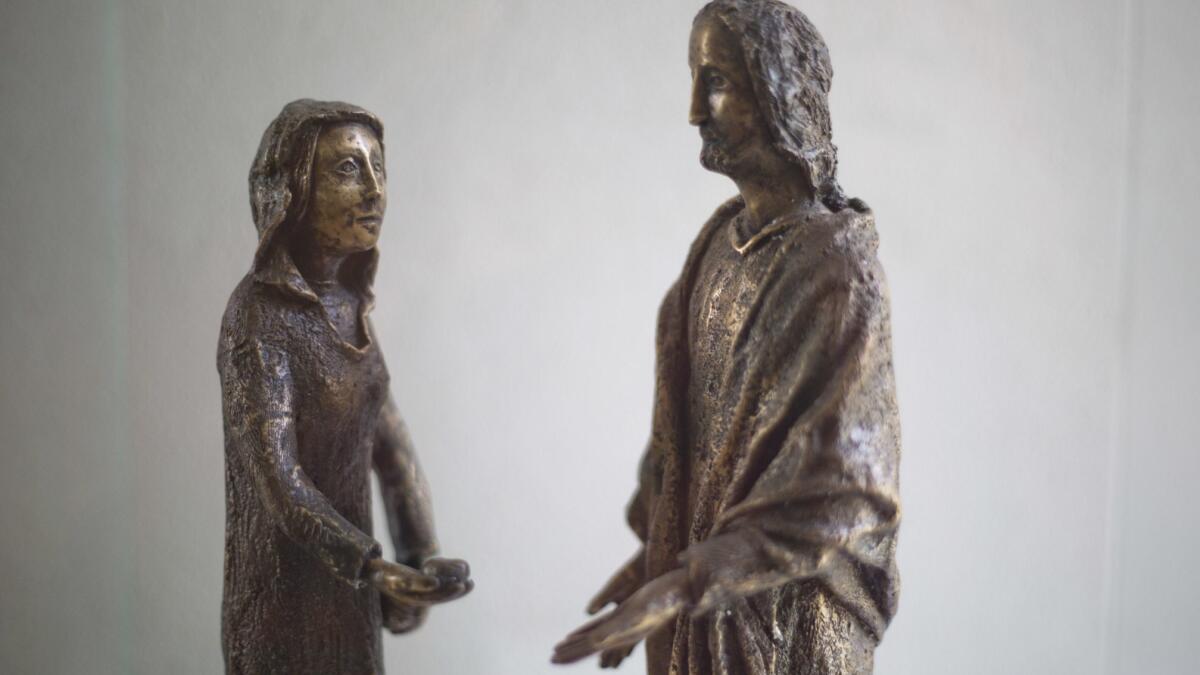Op-Ed: Mary Magdalene doesn’t need a feminist makeover

- Share via
Just in time for Easter, Universal Pictures’ Focus Films released “Mary Magdalene,” starring Rooney Mara as Jesus of Nazareth’s most famous female follower, and Joaquin Phoenix (Mara’s current love interest) as Jesus himself. The United States was supposed to be on the distribution list, but the distributor was Weinstein Co., currently in bankruptcy, so the release here is on indefinite hold.
The film, which presents Magdalene as a young woman who flees an arranged marriage, is part of a feminist effort to “refute,” in the words of a BBC article, the centuries-old and “commonly accepted orthodoxy that Mary of Magdala was a prostitute” redeemed by Jesus. There is a patriarchal villain behind the supposed sex-worker slander: 6th century Pope Gregory I, who may have expanded on the story of the anonymous woman, described in Luke’s Gospel as a “sinner,” who washed Jesus’ feet with her tears and wiped them dry with her hair. The fallen/saved, foot-washing Mary Magdalene is revered by Catholic and Protestant alike.
“I don’t know how to love him,” she laments in Andrew Lloyd Weber’s 1970 rock opera “Jesus Christ Superstar,” scheduled for a live-concert Easter Sunday performance on NBC. “I’ve had so many men….”
It’s the fallen part that amounts to character assassination for many of today’s feminist theologians. In their view, turning Magdalene into a one-time prostitute is just the final damning step in an authoritarian church process that systematically marginalized a woman who was a powerful leader among Jesus’ followers. Some Bible scholars say Magdalene nearly was written out of the New Testament entirely, with only the Gnostics and other heretics venerating her as an example of the “legitimacy of women’s leadership,” writes Harvard Divinity School professor Karen L. King.
We should not glibly assume that Mary Magdalene is in need of rehabilitation by us moderns.
The feminists are correct that Mary Magdalene is an enigmatic figure in the Bible. The New Testament says not a word about her past, except that Jesus had cast seven devils out of her before she joined his followers. But the idea that she needs rescuing from a reputation blackened by erroneous association with commercial sex doesn’t accord with actual history. If anything, early Christians loved her all the more for her reputation. Two popular early saints, subjects of many an icon, were Thais and Mary of Egypt, courtesans in Alexandria during different centuries, who, according to legend, had become notorious (and Thais quite wealthy) for selling their sexual favors. Both were miraculously converted and spent the rest of their lives in penance and prayer.
Early and medieval Christians were quite aware that Mary Magdalene had played a special and powerful role in Jesus’ ministry. John’s Gospel reports that she, and not one of the male apostles, was the first person to encounter Jesus after his resurrection from the dead. It was Magdalene who informed “those who had been with him” that he was alive.
Thomas Aquinas, in the 13th century, gave her the title “apostle to the apostles,” following the lead of the Eastern church, which has traditionally held her to be the disciples’ equal. (Pope Francis adopted Thomas’s title for Magdalene when he elevated the rank of her July 22 feast day in 2016.) The plot of Dan Brown’s “The Da Vinci Code,” which has Magdalene as Jesus’ widow traveling from Jerusalem to France after his death, is a garbled version of a medieval legend in which she is cast adrift in a rudderless boat by persecutors, miraculously lands in Marseille and starts preaching Christ to the pagans there.
“All who heard her were in admiration of her beauty, her eloquence, and the sweetness of her message,” one chronicler wrote.
In her 2000 book, “The Making of the Magdalen,” Katherine L. Jansen, a historian at the Catholic University of America, points out that as the Middle Ages progressed, Mary Magdalene became the most beloved Catholic saint after the Virgin Mary. Churches all over Europe were named after her, as were colleges at Oxford and Cambridge. In France two competing pilgrimage sites claimed to hold her bones. Fusing the holy and the erotic, as befits her reputed history, Magdalene starred for many centuries in legend, drama, devotional tracts, and above all, visual art that celebrated her washing Jesus’ feet, weeping at the foot of the cross, encountering the risen Lord and meditating on her past. (One of the most striking examples is Georges de la Tour’s 1640 painting, “The Magdalene with the Smoking Flame,” at the Los Angeles County Museum of Art.) People believed that if one of the greatest sinners could become one of the greatest saints, she could effectively intercede with God on their behalf.
We should not glibly assume that Mary Magdalene is in need of rehabilitation by us moderns. She might never have sold her body, but she stands as witness to female sinners, including harlots and adulteresses whom the Gospels do record as receiving Jesus’ boundless love. She stands for the idea that any of us, with our human failings and transgressions, can receive that, too.
Charlotte Allen holds a doctorate in medieval studies from the Catholic University of America.
Follow the Opinion section on Twitter @latimesopinionand Facebook
More to Read
A cure for the common opinion
Get thought-provoking perspectives with our weekly newsletter.
You may occasionally receive promotional content from the Los Angeles Times.






